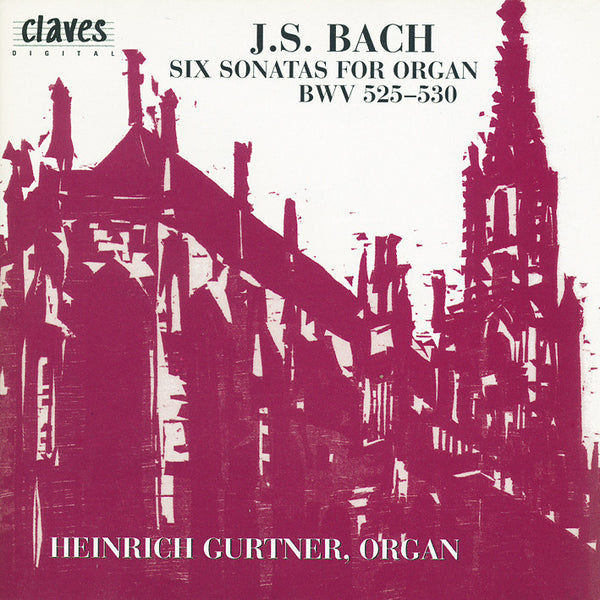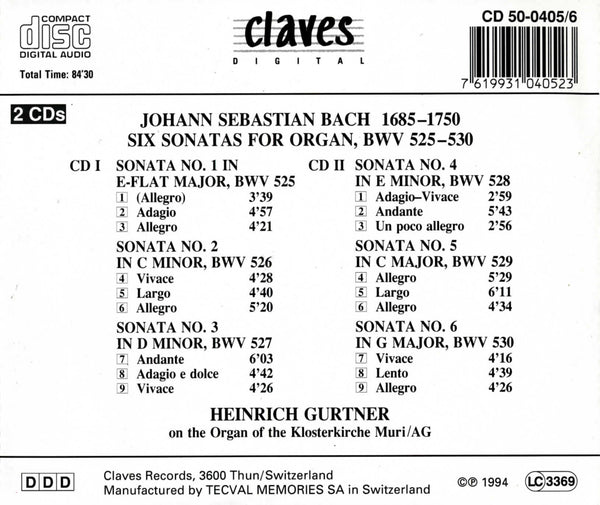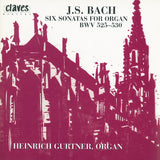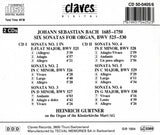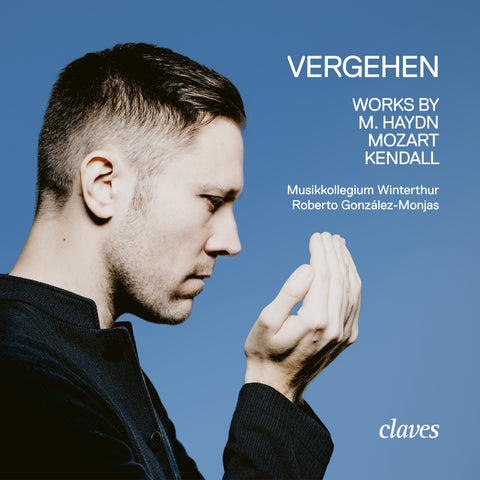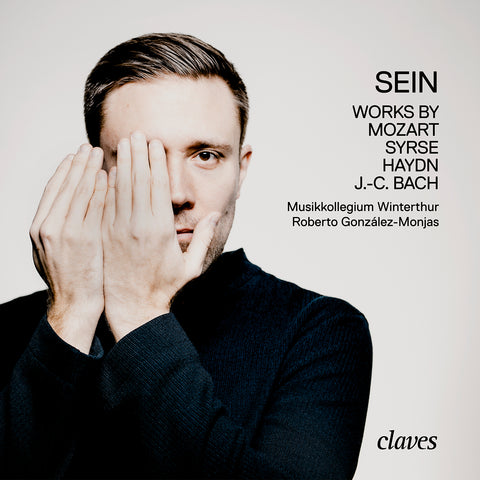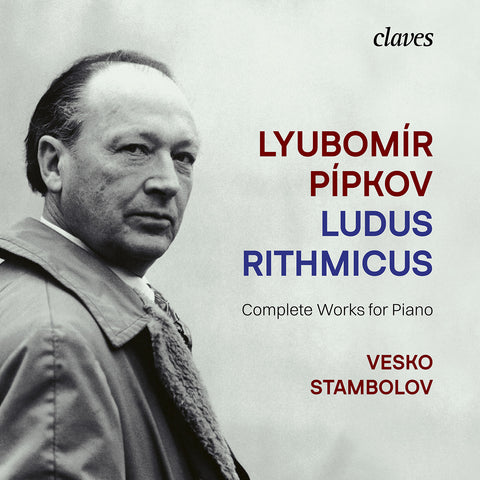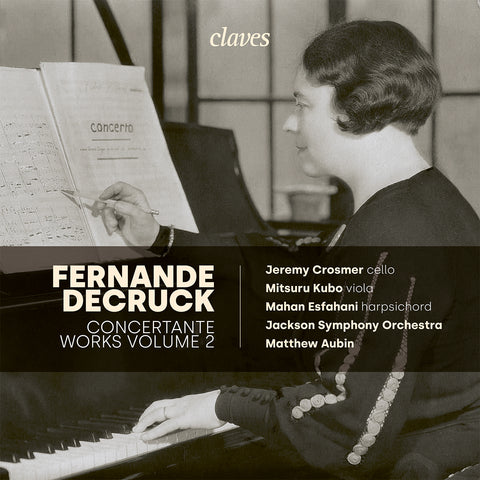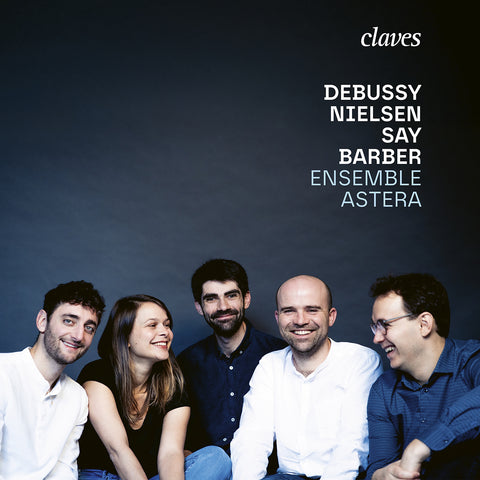(1994) Bach: The Six Trios Sonatas for Organ
Kategorie(n): Alte Musik
Instrument(e): Orgel
Hauptkomponist: Johann Sebastian Bach
CD-Set: 2
Katalog Nr.:
CD 405-6
Freigabe: 1994
EAN/UPC: 7619931040523
- UPC: 829410603362
Dieses Album ist jetzt neu aufgelegt worden. Bestellen Sie es jetzt zum Sonderpreis vor.
CHF 24.00
Dieses Album ist nicht mehr auf CD erhältlich.
Dieses Album ist noch nicht veröffentlicht worden. Bestellen Sie es jetzt vor.
CHF 24.00
Dieses Album ist nicht mehr auf CD erhältlich.
CHF 24.00
Inklusive MwSt. für die Schweiz und die EU
Kostenloser Versand
Dieses Album ist nicht mehr auf CD erhältlich.
Inklusive MwSt. für die Schweiz und die EU
Kostenloser Versand
Dieses Album ist jetzt neu aufgelegt worden. Bestellen Sie es jetzt zum Sonderpreis vor.
CHF 24.00
Dieses Album ist nicht mehr auf CD erhältlich.
This album has not been released yet.
Pre-order it at a special price now.
CHF 24.00
Dieses Album ist nicht mehr auf CD erhältlich.
CHF 24.00
Dieses Album ist nicht mehr auf CD erhältlich.
SPOTIFY
(Verbinden Sie sich mit Ihrem Konto und aktualisieren die Seite, um das komplette Album zu hören)
BACH: THE SIX TRIOS SONATAS FOR ORGAN
Much has been written about the question if these works were originally intended to be performed on an organ or a harpsichord with two manuals and pedal (the instrument for practice at home). Spitta and Schweitzer were both of the opinion that it was incorrect to speak of these compositions as “organ sonatas”. The heading “à 2 Clav: et pedal” that stands at the beginning of each sonata leaves both possibilities open, and it is certain that the rich palette of colors of a Baroque organ is particularly suitable for distinguishing the three individual voices. Individual movements, by the way, were expressly designated for the organ: the Finale from the fourth sonata was originally conceived as a middle movement between the prelude and fugue in G major, BWV 541, and the largo from the fifth sonata was likewise intended to appear between the prelude and fugue in C major, BWV 545.
Two other movements provide insight into the common contemporary practice of arranging works (whether of one’s own or by another composer) for different instrumental settings. The first movement (Adagio-Vivace) from the fourth sonata is a transcription of the Sinfonia for oboe d’amore, viola da gamba and basso continuo from Cantata No. 76 (“Die Himmel erzählen die Ehre Gottes”); it is particularly enlightening to observe how Bach altered the original instrumental continuo line for the organ pedal. Bach arranged the Adagio e dolce from the third sonata a few years later for the slow movement of his triple concerto in A minor.
Even more than for their pedagogical value, the sonatas are notable for their musical beauty and significance. Although on the surface they are all similar (three movements, fast-slow-fast), the sonatas contain an overwhelming diversity of form and expression. Their special place within the whole of Bach’s compositional output was recognized very early, as is demonstrated in closing by two citations:
An anonymous author (most likely Carl Philipp Emanuel Bach) wrote in the article “Bach and Händel, a comparison” from the year 1788: “Various trios for the organ have become known, particularly six for two manuals and pedal which are written in such gallant style that they still sound very good, and never grow old, but on the contrary will outlive all revolutions of fashion in music.” Furthermore, Johann Nikolausa Forkel wrote about the sonatas in 1802: “One cannot say enough about their beauty.”
Heinrich Gurtner
Translation: Mark Manion
(1994) Bach: The Six Trios Sonatas for Organ - CD 405-6
The six sonatas or trios for two manuals with obbligato pedal were most likely completed shortly after 1727. “Bach drew them up for his eldest son Wilhelm Friedemann, who had to prepare himself by this means to become the great organ-player that he was afterwards”. (Forkel) Like the Orgelbüchlein and the third part of the Clavierübung, these pieces were conceived to serve primarily pedagogical purposes. As Schweitzer once said, they remain to be the Gradus ad parnassum for every organist. Every irregularity of performance is exposed pitilessly by the transparent three-part texture of these compositions. The technical difficulties of the sonatas make great demands on the organist, who must be able to play three voices completely independently with regard to phrasing and articulation.
Much has been written about the question if these works were originally intended to be performed on an organ or a harpsichord with two manuals and pedal (the instrument for practice at home). Spitta and Schweitzer were both of the opinion that it was incorrect to speak of these compositions as “organ sonatas”. The heading “à 2 Clav: et pedal” that stands at the beginning of each sonata leaves both possibilities open, and it is certain that the rich palette of colors of a Baroque organ is particularly suitable for distinguishing the three individual voices. Individual movements, by the way, were expressly designated for the organ: the Finale from the fourth sonata was originally conceived as a middle movement between the prelude and fugue in G major, BWV 541, and the largo from the fifth sonata was likewise intended to appear between the prelude and fugue in C major, BWV 545.
Two other movements provide insight into the common contemporary practice of arranging works (whether of one’s own or by another composer) for different instrumental settings. The first movement (Adagio-Vivace) from the fourth sonata is a transcription of the Sinfonia for oboe d’amore, viola da gamba and basso continuo from Cantata No. 76 (“Die Himmel erzählen die Ehre Gottes”); it is particularly enlightening to observe how Bach altered the original instrumental continuo line for the organ pedal. Bach arranged the Adagio e dolce from the third sonata a few years later for the slow movement of his triple concerto in A minor.
Even more than for their pedagogical value, the sonatas are notable for their musical beauty and significance. Although on the surface they are all similar (three movements, fast-slow-fast), the sonatas contain an overwhelming diversity of form and expression. Their special place within the whole of Bach’s compositional output was recognized very early, as is demonstrated in closing by two citations:
An anonymous author (most likely Carl Philipp Emanuel Bach) wrote in the article “Bach and Händel, a comparison” from the year 1788: “Various trios for the organ have become known, particularly six for two manuals and pedal which are written in such gallant style that they still sound very good, and never grow old, but on the contrary will outlive all revolutions of fashion in music.” Furthermore, Johann Nikolausa Forkel wrote about the sonatas in 1802: “One cannot say enough about their beauty.”
Heinrich Gurtner
Translation: Mark Manion
Return to the album | Composer(s): Johann Sebastian Bach | Main Artist: Henrich Gurtner







